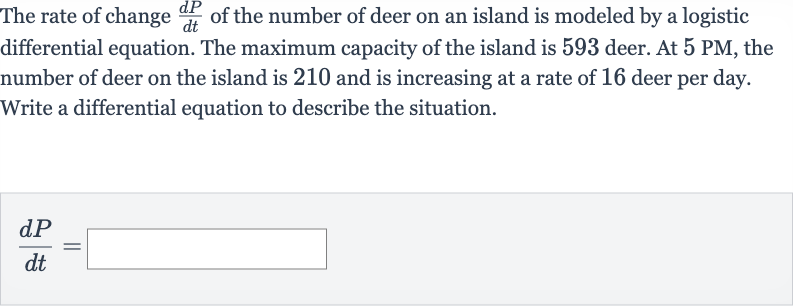AI tutor
Welcome to Bytelearn!
Let’s check out your problem:

The rate of change of the number of deer on an island is modeled by a logistic differential equation. The maximum capacity of the island is deer. At , the number of deer on the island is and is increasing at a rate of deer per day. Write a differential equation to describe the situation.
Full solution
Q. The rate of change of the number of deer on an island is modeled by a logistic differential equation. The maximum capacity of the island is deer. At , the number of deer on the island is and is increasing at a rate of deer per day. Write a differential equation to describe the situation.
- Logistic Differential Equation: The logistic differential equation is generally given by the formula:where:- is the population at time ,- is the intrinsic growth rate of the population,- is the carrying capacity of the environment (maximum population size),- is the rate of change of the population with respect to time.
- Given Carrying Capacity: We are given that the carrying capacity is deer. This value will be used in our differential equation.
- Initial Population Data: We are also given that at PM, the number of deer is and is increasing at a rate of deer per day. This information will help us determine the intrinsic growth rate .
- Calculate Intrinsic Growth Rate: To find the intrinsic growth rate , we use the given rate of change of the population when . We plug these values into the logistic equation and solve for :
- Calculate Fraction: First, calculate the fraction of the carrying capacity that the current population represents:
- Subtract Fraction: Perform the division to find the fraction:
- Multiply by Population: Subtract this fraction from to find the term :
- Divide Rate of Change: Now, multiply this term by the current population :
- Calculate Value of r: Finally, divide the given rate of change of the population by this product to solve for :
- Write Logistic Differential Equation: Perform the division to find the value of :
- Write Logistic Differential Equation: Perform the division to find the value of :Now that we have the value of , we can write the logistic differential equation:
More problems from Write exponential functions: word problems
QuestionGet tutor help
QuestionGet tutor help
QuestionGet tutor help
QuestionGet tutor help
QuestionGet tutor help
QuestionGet tutor help
QuestionGet tutor help
QuestionGet tutor help
QuestionGet tutor help
